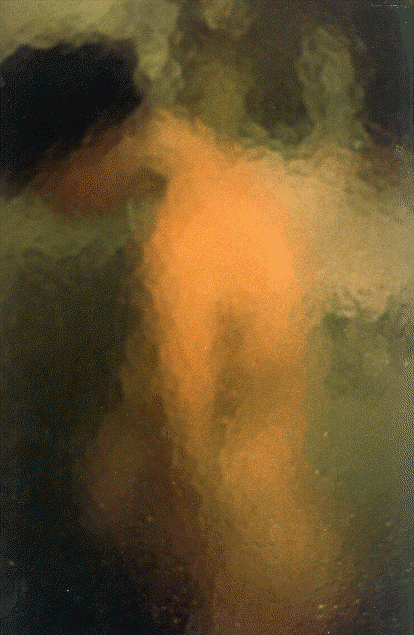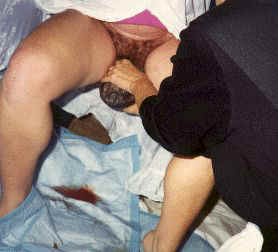The Case Against its Routine Use -- A review of literature, |
|
Unauthorized
Reprint of an article |
"Extraordinary
claims require |
**Editor's NOTE: The following article and literature review on episiotomy is a reprint of an email originally posted 9/13/97on OBGYN.NET, an Internet discussion group for obstetricians and professional midwives. Its contents reveals the truth about the historical and contemporary use of episiotomy, which is a painful, detrimental and potentially fatal surgical procedure unnecessary to normal childbirth but none the less used routinely by the medical profession. Despite a total lack of scientific basis for its routine use and the pain and complications associated with it, routine episiotomy has been the "management of choice" by the obstetrical community for the last 100 years.
Episiotomy is associated with an statistically significant increase in 3 and 4th degree lacerations (into or through the rectal sphincter), perineal edema, inability to urinate after the birth (requiring caterization and increased rate of urinary tract infections), on-going perineal pain requiring medications and interfering with maternal mobility and breastfeeding and difficulty or pain in resuming normal sexual intercourse postpartum. Episiotomy does not protect the mother from pelvic floor damage or future incontinence of bladder or bowel. It does however increase the likelihood of immediate post-op infections and perineal lacerations in future pregnancies. It increase the cost of maternity care and the length of recovery for the mother.
The only medical justification for its use is to hasten the birth of a baby suffering from fetal distress during the last few minutes of the birth process or in response to maternal exhaustion (and then only after informed consent information is provided and after obtaining the mother's permission). Its emergency use is extremely rare and when necessary is often a consequence of non-physiological (i.e., medical) management of the second stage of labor including the use of pain medications or anesthesia or requiring the mother to push while lying on her back while instructing the mother in prolonged breath-holding (longer than 5 or 6 seconds per inspiration).
In addition to the physical and psychological damage done to individual mothers by inappropriate use of episiotomy (extensively documented in this treatise by Dr. Woolley), its historical acceptance by the medical profession as the basis of the "normal" management of birth resulted in a serious deficiency in medical education with long term consequences. Contemporary obstetricians have never been taught (nor chosen to learn on their own) these protective principles which are far more appropriate than episiotomy and necessary to preserve the normalcy of the pelvic floor. Appropriate non-surgical (i.e. midwifery-based) protective methods require a through understanding of how to facilitate the normal physiology of birth to the benefit of the mother's perineal tissue, which includes such principles as patience with nature, right use of gravity, delivery in a side-lying position, and techniques such as maintaining flexion of the fetal head and supporting the perineum during the birth of the baby's head and again during the delivery of the shoulders. A side-lying delivery technique was recommended historically to the medical profession and demonstrated by Dr. DeLee in photographs in his 1924 obstetrical textbook "Principles and Practice of Obstetrics". However, the medical profession has always ignored this recommendation, preferring to put women in a lithotomy position (mother on her back with feet in stirrups) and depend on episiotomies instead.
Having chosen to surgically cut open the perineum, the obstetrical profession has never acknowledged the traditional midwifery principles and non-medical management techniques which were naturally successful at preventing perineal trauma during childbirth, These protective principles requires that upright and mobile positions be used for second stage (right use of gravity). The right use of gravity stimulates labor, dilates the cervix and helps the baby descend through the bony pelvis. Encouraging the mother to be upright and mobile not only helps labor progress normally but diminishes the mother's perception of pain, perhaps by stimulating endorphins. To ignore the well-known relationship of gravity to spontaneous progress is to do so at the peril of mother and baby. Specifically, it is critical that doctors do not place the mother in a position for delivery (i.e. on her back) which includes weight bearing on the maternal sacrum as this closes down the bony pelvis by approximately one third while requiring the baby to be pushed uphill against gravity at a 60 degree angle through a partially closed door. This can result in fetal distress, maternal exhaustion, unnatural perineal lacerations, edema, pain and inability to urinate immediately after the birth and pain in resuming normal intercourse postpartum. The baby as well as the mother may suffer from this institutionalized ignorance and require care in a neonatal intensive care nursery for several days after birth or even have permanent neurological damage from a trip through the birth canal make unnaturally perilous by imposing non-physiological and
As if the inappropriate use of episiotomy for the last 100 years was not bad enough already, things have taken a desperate (and potentially fatal) turn for the worse within the last few years via a call by obstetricians for "prophylactic" cesareans as the delivery method of choice. Because obstetricians do not utilize "good technique" in managing the perineal stage of the birth (a combined problem of inappropriate use of episiotomy and failure to make right use of gravity with an increased rate of perineal lacerations when episiotomy is not done) there is a marked increase in pelvic floor difficulties, especially for older women, such as incontinence, uterine prolapse, etc. This problem is so pervasive that 33% of obstetricians in the United Kingdom who were asked for their personal birth preference (or for wives and daughters) between normal vaginal birth or elective cesarean, identified elective cesarean as the one they would choose. They attributed this to a fear of pelvic floor damage subsequent to normal birth. Obviously these iatragenically-created problems are considered by doctors to be unpreventable and to represent the "collateral damages" of childbirth -- proof of a fatal design flaw that can only be overcome by avoiding vaginal birth all together!
The possibility of pelvic floor damage subsequent to vaginal birth is now being cited by the president of ACOG as a rationale for medically unnecessary "elective" cesarean becoming the delivery method of choice. Logically-speaking this means that absence of ability of modern obstetrics to utilize historically successful non-surgical protective methods of perineal management translate into the use of Cesarean surgery as a bizarre indirect way to "protect" the pelvic floor, However Cesareans are not a simple perineal "protective" procedure but instead are a life-threatening surgical intervention associated with many complications for both mothers and babies. In addition to complications of the time of the original surgery, complications can occur in a subsequent pregnancy such as placenta previa, placenta percreta and uterine rupture with fetal demise or a baby with permanent neurological damage. It is a classic domino situation in which ignorance by physicians of successful midwifery techniques for perineal management can, for some childbearing women, cause extremely detrimental or even fatal consequences. The 1966 edition of Davis Obstetrics' puts things very succinctly "There can be no alibi for not knowing what is known." Surely this situation should be rectified sooner rather than later.
In an attempt to address this generally pernicious situation I reprinted Dr. Woolley's emailed article on the GoodNewsNetWork web site at the time it was published on the OBGYN.NET (September 1997). Dr. Woolley subsequently informed me of his plan to publish this important material in a peer review journal. At his request I removed the material from the web site as I did not want any way to compromise his ability to publish this extremely important information. It is now four years later and his article has still not been published. The obstetrical community still does not utilize "good technique" in managing the perineal stage of the birth (combined problems of inappropriate rate of episiotomy, lack of patience and failure to make right use of gravity). Pelvic floor disorders, especially for older women continue to be far too frequent. The president of ACOG is now promoting the use of medically unnecessary "elective" cesarean as the delivery method of choice and arguments against VBAC are being circulated in medcial journal and in the public press and national media. Single Closure method of uterine repair after CS increases the rate of uterine rupture in subsequent pregnancies, putting mothers and babies at risk in future pregnancies. This a totally unacceptable situation which must be rectified sooner rather than later.
Therefore I have again posted Dr Woolley's artice, without his permission and over his vigorous objections (made via email and telephone). He considers its inclusion to be an ethical violation of his rights as its author. I consider the unnecessary and unwise use of episiotomy by the medical profession to be an ethical violation (if not a crime!) against childbearing women and believe that women have the right to know what doctors already know (but do not put into practice) or at very best, give merest lip service but without the knowledge or skills to carry out safely.
Under the copy write principle of "fair use" I have posted Dr. Woolley's academic research on the wrongful use of episiotomy on this web site. I receive no personal, professional or financial benefit whatsoever from the presentation of this material. Circulating this important information is the only way to inform childbearing women of their need to protect themselves from this unnecessary medical procedure by providing them with an irrefutable source of information (that is, data compiled and presented by another physician) that they may reprint and give to their doctor, along with a directive to their physician to reframe from the routine use of episiotomy and additional instructions for their physician on non-medical methods to protect the mother's perineum from accidental laceration during the birth of their baby.
As web wife to www.CollegeofMidwives.org, I apologize for upsetting Dr. Woolley. I continue to hope that he will actually publish this important material and receive the recognition due to him for his excellent academic research and writing skills and his willingness to tell the truth about an institutionalized form of malpractice that is the "dirty little secret" of the medical profession. It is too good a piece of writing to languish on a not-for-profit web site read by the few hundred midwives and childbearing women who visit this Internet site each year.
|
Excerpts of Immediate interest: |
|

